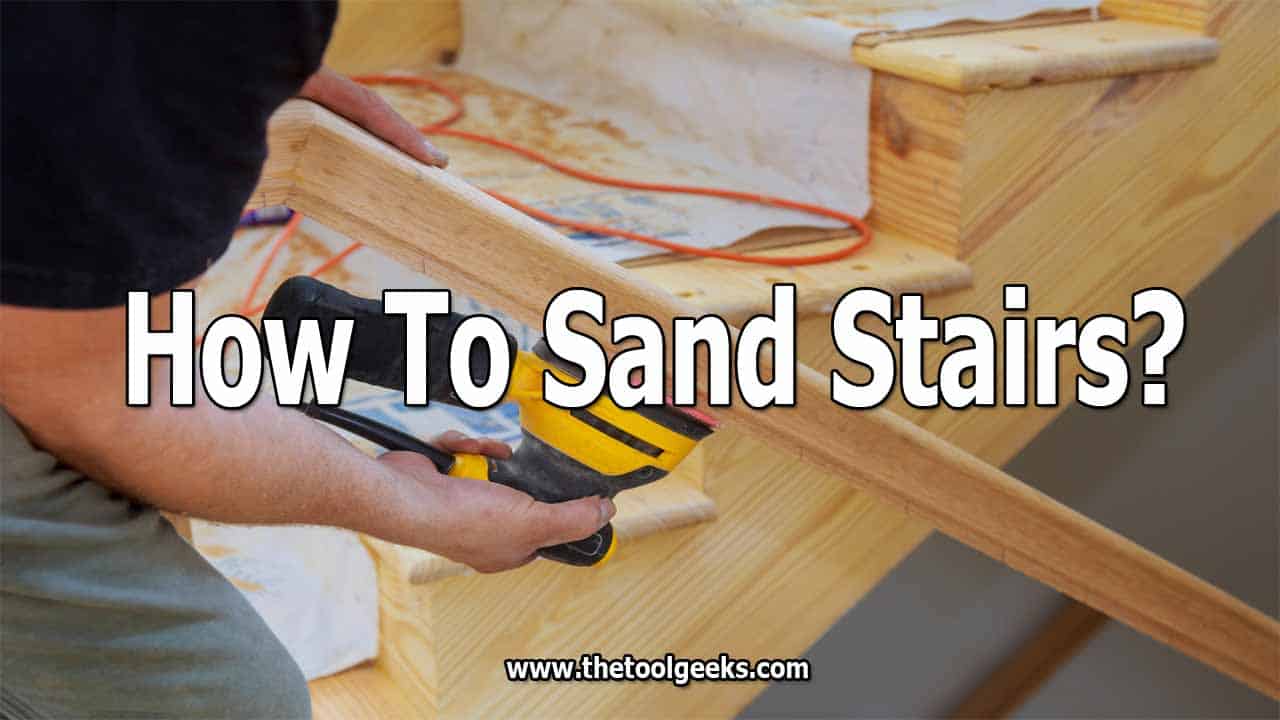How To Sand Stairs (6 Steps): Make Your Stairs Look Good Again
TheToolGeeks.com is a participant in the Amazon Services LLC Associates Program and other affiliate advertising programs. We may earn from qualifying purchases. (Learn More).
If you are looking to renovate the staircase in your home, then you need to know how to sand stairs. Having stairs in your home gives you that extra touch of class and style. Stairs are also an alternative way of setting boundaries in your home.
We all have private rooms and storage spaces in our home that we don’t want just anyone gaining access to. Having stairs leading to elevated floors gives your visitors the “restricted area” message. However, just like other wooden surfaces in your home, stairs also require a degree of care, management, and sometimes change.
Although, this may not be as frequent as other wooden surfaces. A distinct way of refinishing your stairs is to sand, polish, and paint the wooden surfaces. This may prove quite a hectic task as sanding stairs doesn’t exactly follow the same procedures as sanding your floors, walls, or doors.
Pre-sanding tip for stairs
Before you begin sanding your stairs, there is a basic step you might want to take note of to allow your work to have the desired look, feel, and finish.
You need to determine if your stairs have been waxed or not. This is an important step that determines what kind of finish you will have.
Discovering a waxed floor or staircase can be pretty much obvious to a professional painter or woodworker, but not to an average person. Luckily, finding out if your floor has been waxed or not is a pretty basic task. All you need is a glass of water.
How to determine if your stairs have been waxed?
Put a few drops of water on the stair and leave it for a few hours. If the water turns white, then you know that spot has been waxed and if the water doesn’t add color, then, of course, it has not been waxed.
Waxed floors make sanding a bit more tedious because they have the tendency of gumming-up sandpaper.
So, you need to remove the upper layer on your staircase which is the wax. Generally, there are two types of wax used to finish on the staircase. The Polyurethane and the hard wax.
The Polyurethane:
This type of wax finish is traditionally preferred to the hard wax finish because it has a liquid plastic surface that is able to withstand constant pressure, is water-resistant, and stain friendly. Rather than penetrating the wooden surface, this type of finish stays on the wooden surface.
The downside about the polyurethane is that it is difficult to change just one stair while maintaining or giving it its original look, finish, and color. In simpler terms, to change one stair may require you to change the entire staircase to maintain the even color and finish.
Hard wax:
Unlike polyurethane, the hard wax finish penetrates the wood. This makes it durable, and stronger than the polyurethane. The downside however is that the hard wax is relatively weaker when dealing with water and stains.
It is more suited for homes with adults and no pets or kids that can cause stains or food and water spillage. Also, it is more difficult to remove than the polyurethane because of its grip on the stair.
Tools needed to effectively sand stairs
- Safety gear (gloves, mask, and goggles)
- Carbide scraper or metallic putty knife
- Sander
- A rag or damp cloth
- Sandpaper
Related Read —Best Sander For Stairs
How To Sand Stairs?
Below is the step by step process involved in sanding practically any staircase.

Remove The Wax
First things first, use your safety gear. Put on your gloves, mask, goggles, and anything else you feel you will need. If you find out your floor has been waxed, you need to remove the wax.
To do this, simply use your carbide scraper to remove the top layer of the stairs by using the sharp edge of the scraper to pull up the wax. If it is a hard wax, it will be tougher to pull off so, be careful.
Related Read — Best Sander To Remove Paint
Prep You Sander & Surface
First, get your surface ready for sanding. You can clean it with a rag. After that, you need to prep your sander. For this task, a belt sander is highly recommended.
Gently apply the sandpaper on the sander. For starters, you can use 60-grit sandpaper and increase the grit until you reach your desired level of fineness.
You need to consider that your belt sander can’t get into those corners and angles on your staircase so, you need to have an alternative method in mind. For this task, you can simply wrap sandpaper around a brick.
Related Read —Best Sander For Pallets
Start Sanding
Start sanding. If you have successfully removed the wax on your staircase, cleaned your surface for sanding, and put the required sandpaper on the sander, then you are ready to sand.
Remember you want to even out the surfaces of your staircase with each grit you use so, the surface can have a smooth and fine finish that will accept the paint or finish evenly.
Place your belt sander on each stair, hold with both hands, and apply a bit of pressure but not too much pressure that can damage your wood.
The belt sander is an aggressive tool so be gentle with it. Move the sander back and forth slowly so you can cover every area. While sanding, always make sure you clean and feel the sanded surface to check if you have a desired level of fineness.
If you don’t, increase the grit by removing the previous sandpaper and adding another one then, continue sanding.
Related Read — Wide Belt Sanders Review
Sand Tight Corners
Most times, there is always varnish, paint, and mostly glue around the corners and edges of your staircase. You need to sand these areas too because if you leave them, it will affect the overall beauty of your work.
It can be annoying to find out just a little part of the stair is what ruined the entire job. The first thing to do is to clean the whole surface with a damp cloth. The wetness of the cloth will expose those tight corners where you haven’t sanded.
To sand those corners, pick out the desired sandpaper with grit, fold it into a shape that can reach those corners. A triangular shape is more advisable, or just fold the sandpaper around a flat object like a metal ruler.
Then gently scrub the folded sandpaper against the wood and glue in those corners till the edges are properly sanded.
You want to pay extra attention to the edges around the railing poles on your stairs. They are difficult to reach so, you have to improvise either by using smaller-shaped sandpaper or sanding cones.
Use Wood Filler
After you finish sanding, you may notice some parts of the wooden edges that have been discolored or damaged from the previous carpet, rug or wax so you can just cover these areas with wood filler and even it out.
Learn More — How To Sand Concrete Floor?
Enjoy Your Work
When you are completely satisfied with your result, vacuum off excess debris on your stairs and clean with a damp cloth. After this process, you should have a big smile on your face as a result of being pleased with your work.
Safety measures while sanding your stairs
Injuries can occur when you least expect them. That’s why they are called “accidents.” To protect you from getting hurt while sanding, you may want to adhere to the following precautions.
- Always use gloves. Sanding requires a lot of palm activity so use gloves to prevent cuts, bruises, and blisters.
- Put on your goggles, mask, and other protective gear.
- Constantly check your equipment to ensure it is in good condition to continue the task.
- Ensure you are using a belt that fits your belt sander.
If you use the steps above and follow the safety precautions, you will surely have an evened out and ready to finish the stairs.
If any part of this post made your job easier, make sure to leave comments and let us know. Have a nice sanding experience.
Amazon and the Amazon logo are trademarks of Amazon.com, Inc, or its affiliates.

